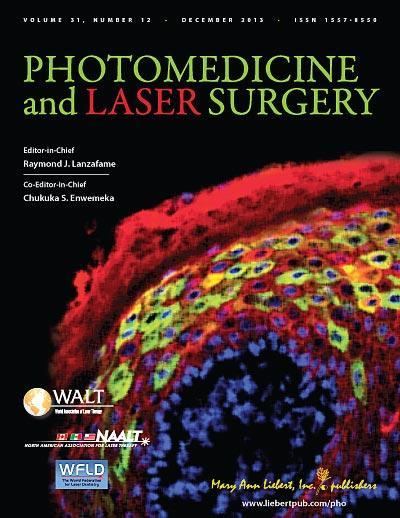New Rochelle, NY, December16, 2013--Blue light has proven to have powerful bacteria-killing ability in the laboratory. The potent antibacterial effects of irradiation using light in the blue spectra have now also been demonstrated in human and animal tissues. A series of groundbreaking articles that provide compelling evidence of this effect are published in Photomedicine and Laser Surgery, a peer-reviewed journal published by Mary Ann Liebert, Inc., publishers. The articles are available on the Photomedicine and Laser Surgery website.
"Bacterial resistance to drugs poses a major healthcare problem," says Co-Editor-in-Chief Chukuka S. Enwemeka, PhD, Dean, College of Health Sciences, University of Wisconsin--Milwaukee, in the accompanying Editorial "Antimicrobial Blue Light: An Emerging Alternative to Antibiotics," citing the growing number of deadly outbreaks worldwide of methicillin-resistant Staphylococcus aureus (MRSA). The articles in this issue of Photomedicine and Laser Surgery provide evidence that "blue light in the range of 405-470 nm wavelength is bactericidal and has the potential to help stem the ongoing pandemic of MRSA and other bacterial infections."
In the article "Effects of Photodynamic Therapy on Gram-Positive and Gram-Negative Bacterial Biofilms by Bioluminescence Imaging and Scanning Electron Microscopic Analysis," Aguinaldo S. Garcez, PhD and coauthors show that photodynamic therapy and methylene blue delivered directly into the root canal of a human tooth infected with a bacterial biofilm was able to destroy both Gram-positive and Gram-negative bacteria, disrupt the biofilms, and reduce the number of bacteria adhering to the tooth.

Photomedicine and Laser Surgery is published online 12 times per year. For more information visit www.liebertpub.com/pho.
(Photo Credit: ©2013, Mary Ann Liebert, Inc., publishers)
Raymond J. Lanzafame, MD, MBA, and colleagues demonstrated significantly greater bacterial reduction in the treatment of pressure ulcers in mice using a combination of photoactivated collagen-embedded compounds plus 455 nm diode laser irradiation compared to irradiation alone or no treatment. The antibacterial effect of the combined therapy increased with successive treatments, report the authors in the article "Preliminary Assessment of Photoactivated Antimicrobial Collagen on Bioburden in a Murine Pressure Ulcer Model."
In the article "Wavelength and Bacterial Density Influence the Bactericidal Effect of Blue Light on Methicillin-Resistant Staphylococcus aureus (MRSA)," Violet Bumah, PhD and coauthors compared the bacteria-killing power of 405 nm versus 470 nm light on colonies of resistant Staph aureus and how the density of the bacterial colonies could limit light penetration and the bactericidal effects of treatment.